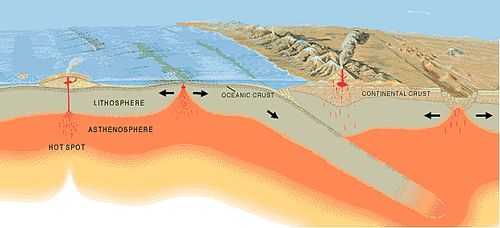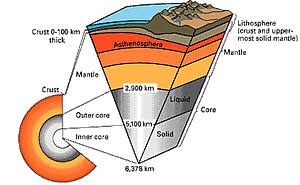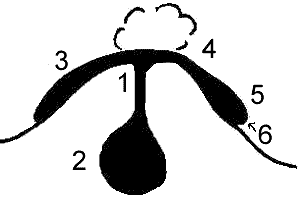BACKGROUND:

The study of volcanoes begins the unit on plate
tectonics. Plate tectonics is a science that investigates the movement of
the Earth's crust. It includes the exterior and interior of the Earth. Both
volcanoes and earthquakes provide data for plate tectonics.
Magma that feeds volcanoes comes from the upper mantle
and lower crust, and not the deep interior of the Earth. Volcanoes were and
are important to the development of the Earth. Lava produced the
"continents" while the Earth was forming. Volcanoes also produced
the water that we have on this Earth, by chemically combining hydrogen and
oxygen inside the Earth, to produce steam which was released when the
volcanoes erupted.
The interaction of the moving plates at boundaries
creates conditions which melt rock. Melted rock is less dense than solid
rock, so it will rise and cause an eruption. The model of plate tectonics
helps explain why and where we have volcanoes. However, some volcanic
action, like the Hawaiian Islands, do not quite fit into the model. Hawaii
is in the middle of the Pacific Plate, not at a plate boundary. This and
other intraplate volcanoes are probably caused by hotspots, which are magma
sources in the Earth’s mantle below the plates. Hotspot magma generation
is not fully understood. The restless Earth is not fully understood, so new
models on volcanic activity can emerge with new data.
PROCEDURE:
 Show the
students the layers of the Earth using the physiographic globe, or use
pictures in Volcano (slideshow). Point out that the magma that feeds volcanoes
comes from the upper mantle and lower crust, and not the deep interior
(core) of the Earth. Explain that plate tectonics movements
involve the crust and upper mantle, which are collectively called the
lithosphere. Students in the fifth grade should have learned about the
shapes of volcanoes and their general classification. If they are not
familiar with volcanoes review the materials from prior grades.
Show the
students the layers of the Earth using the physiographic globe, or use
pictures in Volcano (slideshow). Point out that the magma that feeds volcanoes
comes from the upper mantle and lower crust, and not the deep interior
(core) of the Earth. Explain that plate tectonics movements
involve the crust and upper mantle, which are collectively called the
lithosphere. Students in the fifth grade should have learned about the
shapes of volcanoes and their general classification. If they are not
familiar with volcanoes review the materials from prior grades.
- In lab, the students will look at various types of volcanic rocks.
Review the vocabulary words with the class, emphasizing that the
students will see these rocks in the lab. Remind them that igneous rocks
come from volcanoes or from magma that cooled within the outer portion
of the Earth. Again, use the physiographic globe to emphasize that magma
for volcanoes does not come from the center of the Earth, but only the
crust and upper mantle.
 Review the following diagram and the different types of volcanoes. It
is part of the presentation below, or draw it on the board.
Review the following diagram and the different types of volcanoes. It
is part of the presentation below, or draw it on the board.
- VENT
- MAGMA CHAMBER
- LAVA
- PUMICE, SCORIA
- OBSIDIAN (OUTSIDE)
- BASALT OR ANDESITE (INSIDE THE LAVA FLOW)
- Instruct the students to conduct a web search on volcanoes to find out
more information on their locations; which ones are currently erupting;
and how much damage volcanoes do. The web is full of wonderful sites
that show the majestic mountains formed by volcanoes. Below is a
site that could aid your students, but make sure students perform a
search to find their own sites.
http://www.geo.mtu.edu/volcanoes/
Michigan Technological University - volcano sites from around the world.